Farin G. Curves and Surfaces for CAGD. A Practical Guide
Подождите немного. Документ загружается.

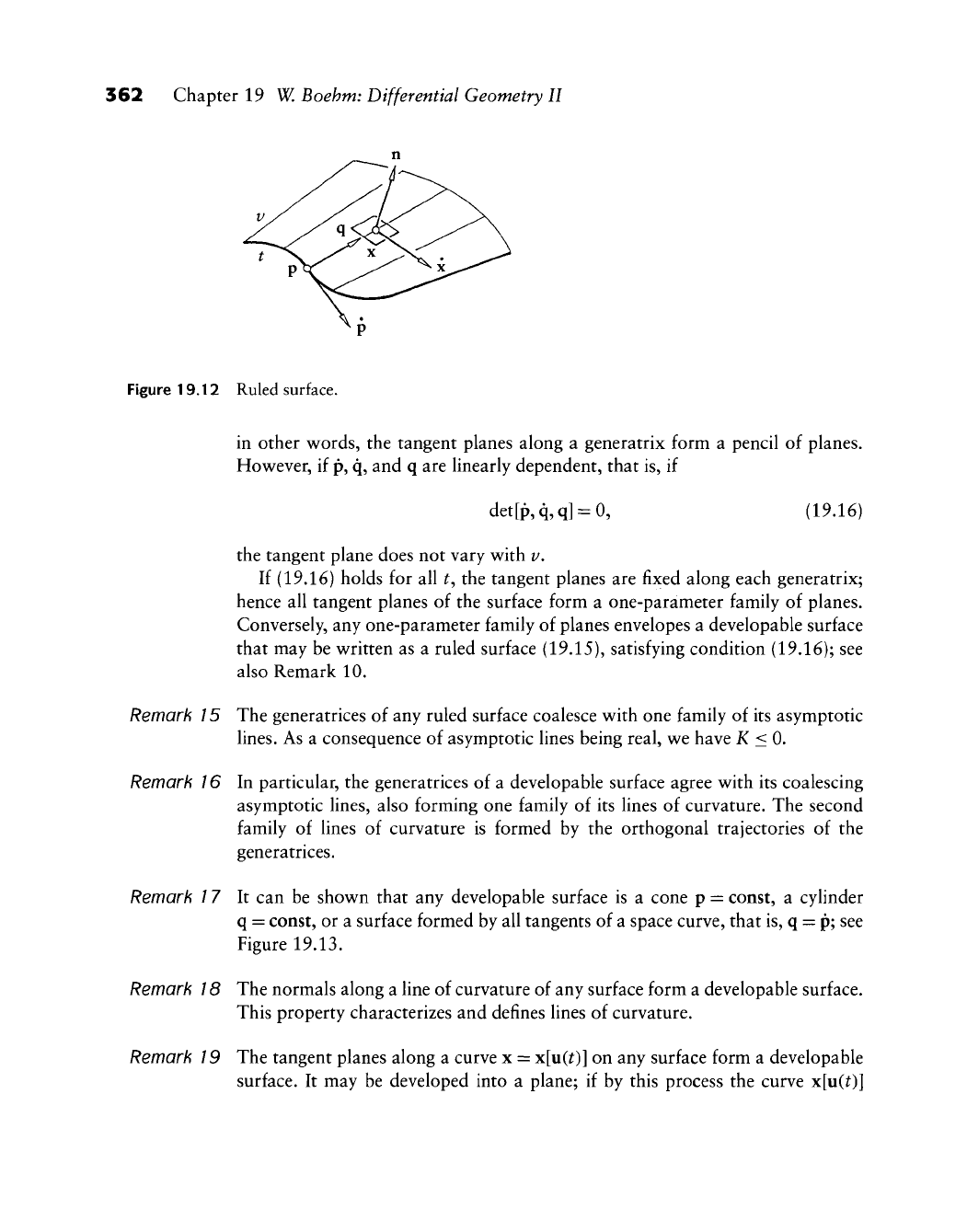
362 Chapter 19 W. Boehm: Differential Geometry II
Figure 19.12 Ruled surface.
in other words, the tangent planes along a generatrix form a pencil of planes.
However, if p, q, and q are linearly dependent, that is, if
det[p,q,q] = 0, (19.16)
the tangent plane does not vary with v.
If (19.16) holds for all f, the tangent planes are fixed along each generatrix;
hence all tangent planes of the surface form a one-parameter family of planes.
Conversely, any one-parameter family of planes envelopes a developable surface
that may be written as a ruled surface (19.15), satisfying condition (19.16); see
also Remark 10.
Remark / 5 The generatrices of any ruled surface coalesce with one family of its asymptotic
lines.
As a consequence of asymptotic lines being real, we have K <0,
Remark 16 In particular, the generatrices of a developable surface agree with its coalescing
asymptotic lines, also forming one family of its lines of curvature. The second
family of lines of curvature is formed by the orthogonal trajectories of the
generatrices.
Remark
1
7 It can be shown that any developable surface is a cone p = const, a cylinder
q = const, or a surface formed by all tangents of a space curve, that is, q = p; see
Figure
19.13.
Remark 18 The normals along a line of curvature of any surface form a developable surface.
This property characterizes and defines lines of curvature.
Remark 19 The tangent planes along a curve x = x[u(0] on any surface form a developable
surface. It may be developed into a plane; if by this process the curve x[u(0]
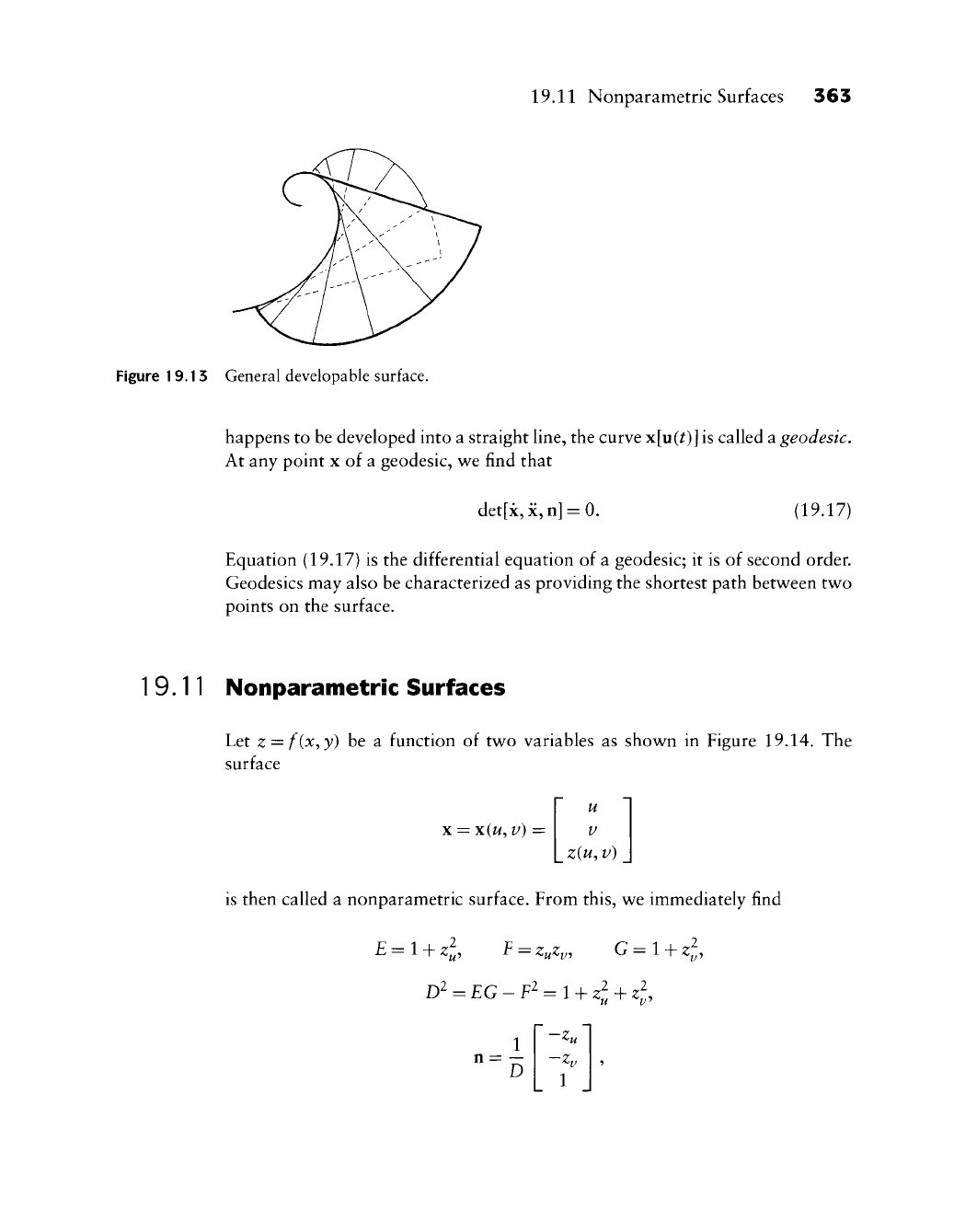
19.11 Nonparametric Surfaces 365
Figure 19.13 General developable surface.
happens to be developed into a straight line, the curve x[u(0] is called a geodesic.
At any point x of a geodesic, we find that
det[x,
X,
n] = 0.
(19.17)
Equation (19.17) is the differential equation of a geodesic; it is of second order.
Geodesies may also be characterized as providing the shortest path betw^een two
points on the surface.
19.11 Nonparametric Surfaces
Let z = f(x,y) be a function of two variables as shown in Figure 19.14. The
surface
X
= x(w, v)
u
V
z(u, v)
is then called a nonparametric surface. From this, we immediately find
D^
= EG-F^ = l + zl + zl,
n =
D
Zy
1
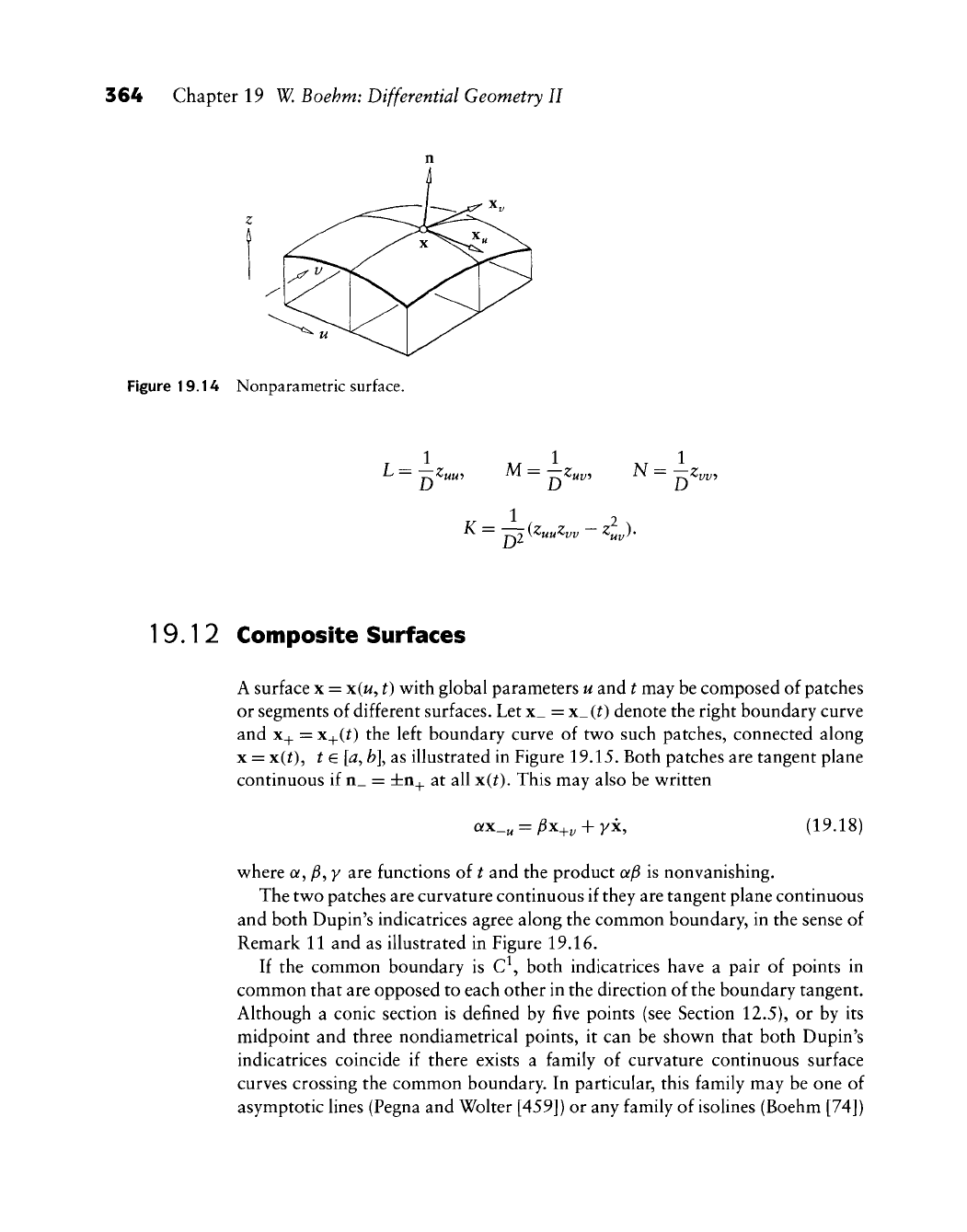
364 Chapter 19 W. Boehm: Differential Geometry II
Figure 19.14 Nonparametric surface.
Ill
D2'
^ T^o y^uu^vv ^uv^'
19.12 Composite Surfaces
A surface x = x(w, t) with global parameters u and t may be composed of patches
or segments of different surfaces. Let x_ = x_(0 denote the right boundary curve
and x_^ = x_^(0 the left boundary curve of two such patches, connected along
X
=
xCO,
t
G
[a^
b\ as illustrated in Figure 19.15. Both patches are tangent plane
continuous if n_ = ibn_^ at all x(^). This may also be written
QfX.
-u
=
P^-hv
+ yx,
(19.18)
where a,
)6,
y are functions of t and the product afi is nonvanishing.
The two patches are curvature continuous if they are tangent plane continuous
and both Dupin's indicatrices agree along the common boundary, in the sense of
Remark 11 and as illustrated in Figure 19.16.
If the common boundary is C\ both indicatrices have a pair of points in
common that are opposed to each other in the direction of the boundary tangent.
Although a conic section is defined by five points (see Section 12.5), or by its
midpoint and three nondiametrical points, it can be shown that both Dupin's
indicatrices coincide if there exists a family of curvature continuous surface
curves crossing the common boundary. In particular, this family may be one of
asymptotic lines (Pegna and Wolter [459]) or any family of isolines (Boehm [74])
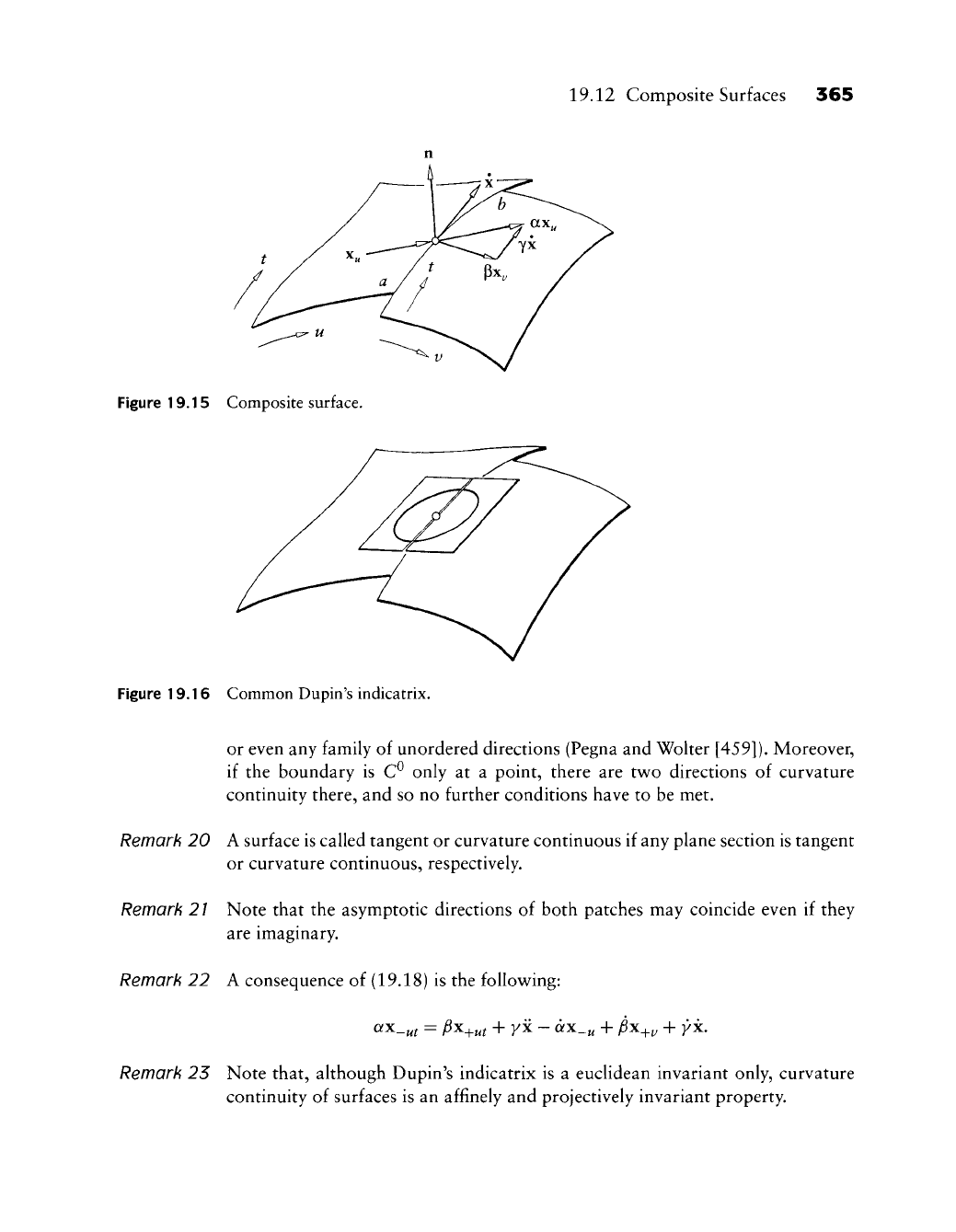
19.12 Composite Surfaces 365
Figure 19.15 Composite surface.
Figure 19.16 Common Dupin's indicatrix.
or even any family of unordered directions (Pegna and Wolter [459]). Moreover,
if the boundary is C^ only at a point, there are two directions of curvature
continuity there, and so no further conditions have to be met.
Remark 20 A surface is called tangent or curvature continuous if any plane section is tangent
or curvature continuous, respectively.
Remark 2 / Note that the asymptotic directions of both patches may coincide even if they
are imaginary.
Remark 22 A consequence of (19.18) is the following:
ax_^t = fix^^t + yx- ax_^ + $x^^ + yx.
Remark 25 Note that, although Dupin's indicatrix is a euclidean invariant only, curvature
continuity of surfaces is an affinely and projectively invariant property.

This Page Intentionally Left Blank
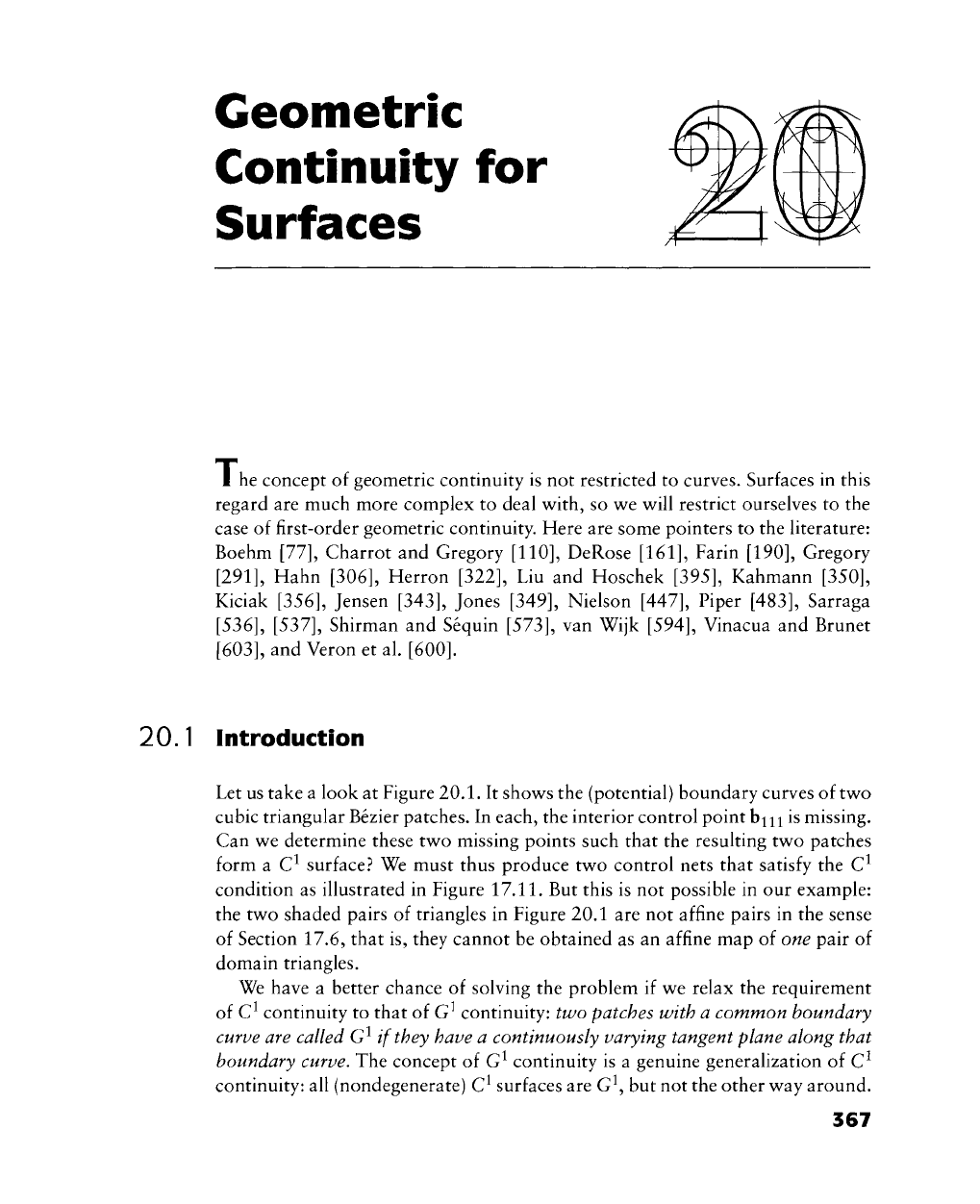
Geometric
Continuity for
Surfaces
I he concept of geometric continuity is not restricted to curves. Surfaces in this
regard are much more complex to deal with, so we will restrict ourselves to the
case of first-order geometric continuity. Here are some pointers to the literature:
Boehm [77], Charrot and Gregory
[110],
DeRose
[161],
Farin
[190],
Gregory
[291],
Hahn
[306],
Herron
[322],
Liu and Hoschek
[395],
Kahmann
[350],
Kiciak
[356],
Jensen
[343],
Jones
[349],
Nielson
[447],
Piper
[483],
Sarraga
[536], [537],
Shirman and Sequin
[573],
van Wijk
[594],
Vinacua and Brunet
[603],
and Veron et al.
[600].
20.1 Introduction
Let us take a look at Figure
20.1.
It shows the (potential) boundary curves of two
cubic triangular Bezier patches. In each, the interior control point bx^ is missing.
Can we determine these two missing points such that the resulting two patches
form a C^ surface.^ We must thus produce two control nets that satisfy the C^
condition as illustrated in Figure
17.11.
But this is not possible in our example:
the two shaded pairs of triangles in Figure 20.1 are not affine pairs in the sense
of Section 17.6, that is, they cannot be obtained as an affine map of one pair of
domain triangles.
We have a better chance of solving the problem if we relax the requirement
of C^ continuity to that of G^ continuity: two patches with a common boundary
curve are called G^ if they have a continuously varying tangent plane along that
boundary curve. The concept of G^ continuity is a genuine generalization of C^
continuity: all (nondegenerate) C^ surfaces are G\ but not the other way around.
367
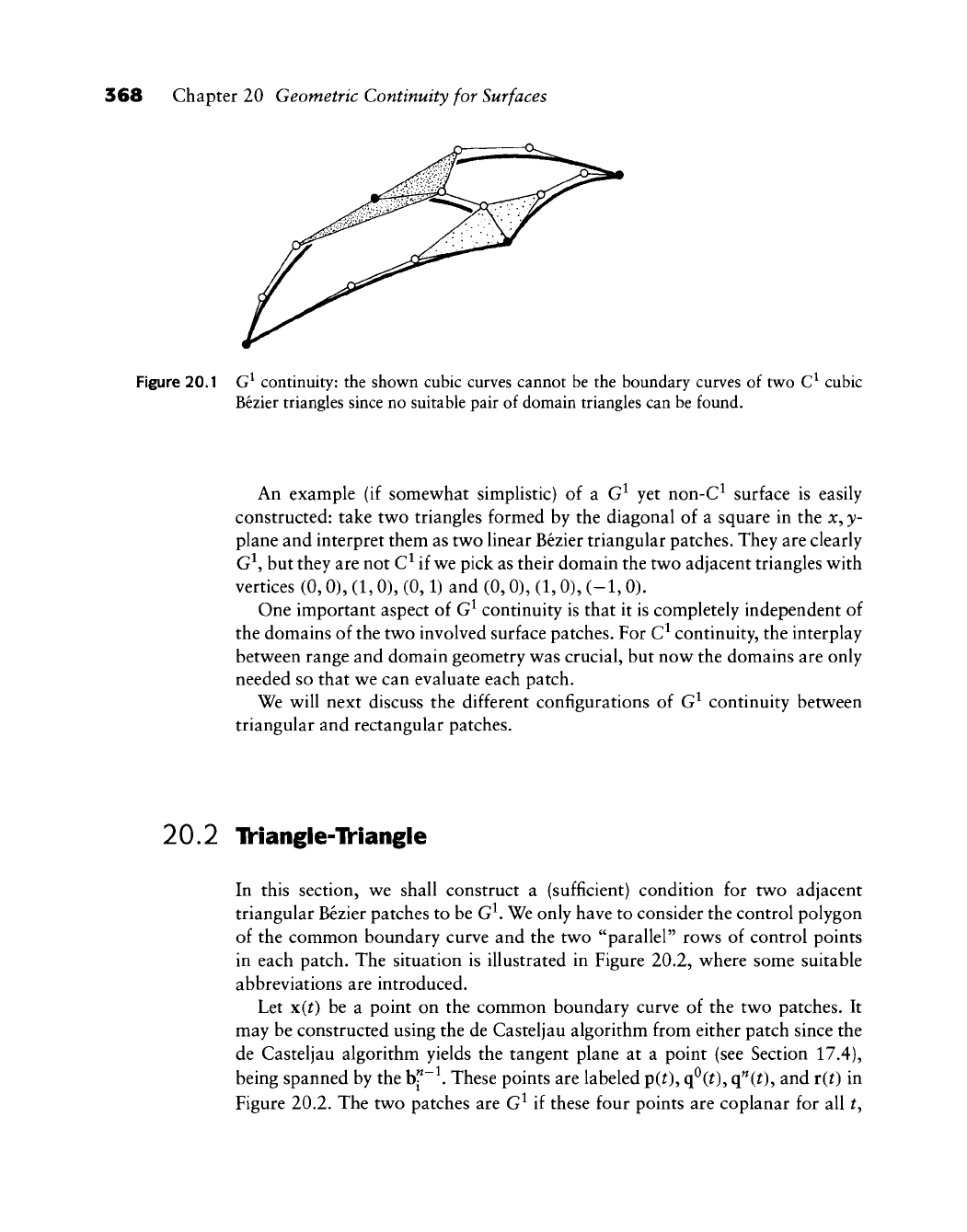
368 Chapter 20 Geometric Continuity for Surfaces
Figure 20.1 G^ continuity: the shown cubic curves cannot be the boundary curves of two C^ cubic
Bezier triangles since no suitable pair of domain triangles can be found.
An example (if somewhat simplistic) of a G^ yet non-C^ surface is easily
constructed: take two triangles formed by the diagonal of a square in the x, y-
plane and interpret them as two linear Bezier triangular patches. They are clearly
G^, but they are not C^ if we pick as their domain the two adjacent triangles with
vertices (0,0), (1,0), (0,1) and (0,0), (1,0), (-1,0).
One important aspect of G^ continuity is that it is completely independent of
the domains of the two involved surface patches. For C^ continuity, the interplay
between range and domain geometry was crucial, but now the domains are only
needed so that we can evaluate each patch.
We will next discuss the different configurations of G^ continuity between
triangular and rectangular patches.
20.2 IV'iangle-TV'iangle
In this section, we shall construct a (sufficient) condition for two adjacent
triangular Bezier patches to be G^. We only have to consider the control polygon
of the common boundary curve and the two "parallel" rows of control points
in each patch. The situation is illustrated in Figure 20.2, where some suitable
abbreviations are introduced.
Let x(t) be a point on the common boundary curve of the two patches. It
may be constructed using the de Casteljau algorithm from either patch since the
de Casteljau algorithm yields the tangent plane at a point (see Section 17.4),
being spanned by the bp^ These points are labeled p(0, q^CO^ q^CO? and T(t) in
Figure 20.2. The two patches are G^ if these four points are coplanar for all t.
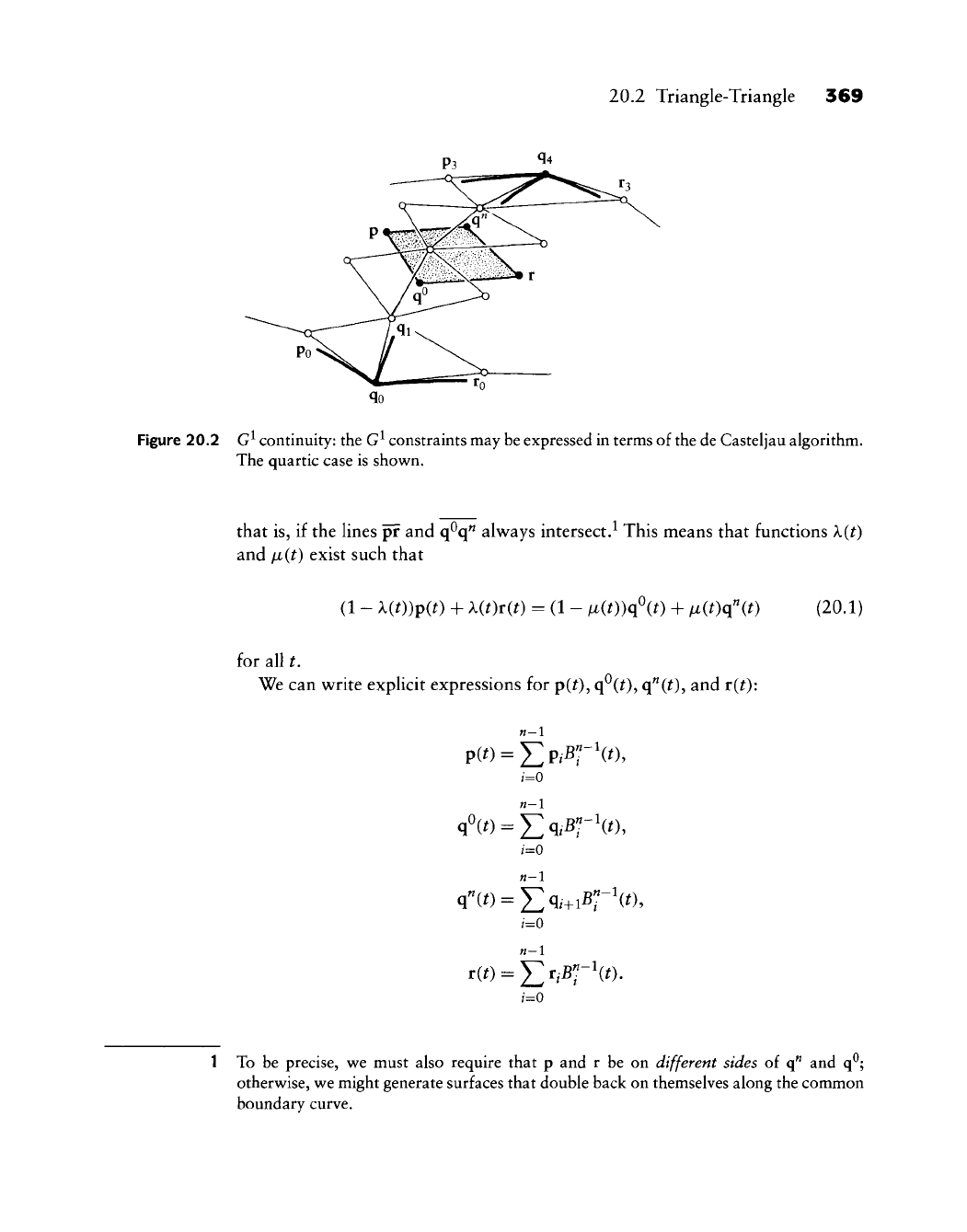
20.2 Triangle-Triangle 369
Figure 20.2
G^
continuity: the
G^
constraints may be expressed in terms of
the
de Casteljau algorithm.
The quartic case is shown.
that is, if the lines pr and q^q" always intersect.^ This means that functions X(t)
and /ji(t) exist such that
(1 - X(t))p(t) + X(t)T(t) = (1 - /x(t))q\t) + /x(Oq"(0 (20.1)
for all t.
We can write explicit expressions for p(0, q^(0? q"(^)) and r{t):
n-l
i=0
i=0
n-l
n-l
=0
1 To be precise, we must also require that p and r be on different sides of q" and q^;
otherwise, we might generate surfaces that double back on themselves along the common
boundary curve.
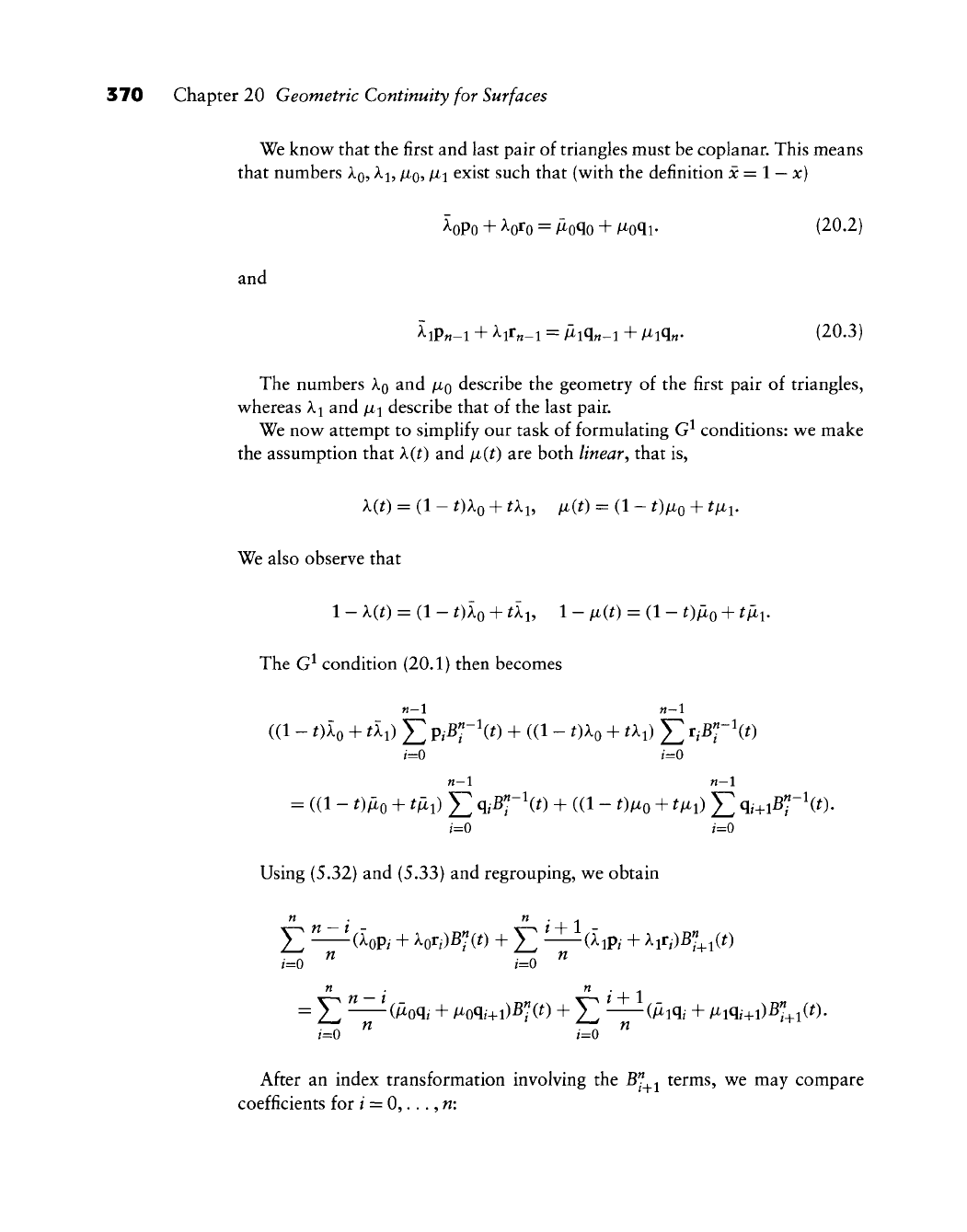
370 Chapter 20 Geometric Continuity for Surfaces
We know that the first and last pair of triangles must be coplanar. This means
that numbers
XQ,
A.^,
/XQ,
MI
exist such that (with the definition x=l
—
x)
^oPo + ^0^0 = Aoqo + /^oqi- (20.2)
and
hPn-i + h^n-i = Aiq«-i + Miq«- (20.3)
The numbers
XQ
and
/XQ
describe the geometry of the first pair of triangles,
whereas k^ and
/JL^
describe that of the last pair.
We now attempt to simplify our task of formulating G^ conditions: we make
the assumption that X(t) and fi(t) are both linear^ that is,
X{t) = (1 - t)ko + ai, fi(t) = (1 - OMO + ^Mi-
We also observe that
1 - X{t) = (1 - 0^0 + t^h
1
- M(0 = (1 - OMO + ^Ai-
The G^ condition (20.1) then becomes
n-l n-l
((1
- 0^0 + tl{) Y, ViK^it) +
((1
- 0^0 + ^^i) E ^i^T^^t)
n-l n-l
= ((1
-
oAo + ti^i) J2
q/-^r^(^)
+ ((1
-
^)^o+^Mi)
E
q^+i^r^w-
Using (5.32) and (5.33) and regrouping, we obtain
,=0 " ,=0 "
= E ^^-^(Aoq,- + Moq,+i)B"(0 + ^ -—(Aiq, + /^iq,+i)B"+i(0.
After an index transformation involving the B"^ terms, we may compare
coefficients for / = 0,..., w:
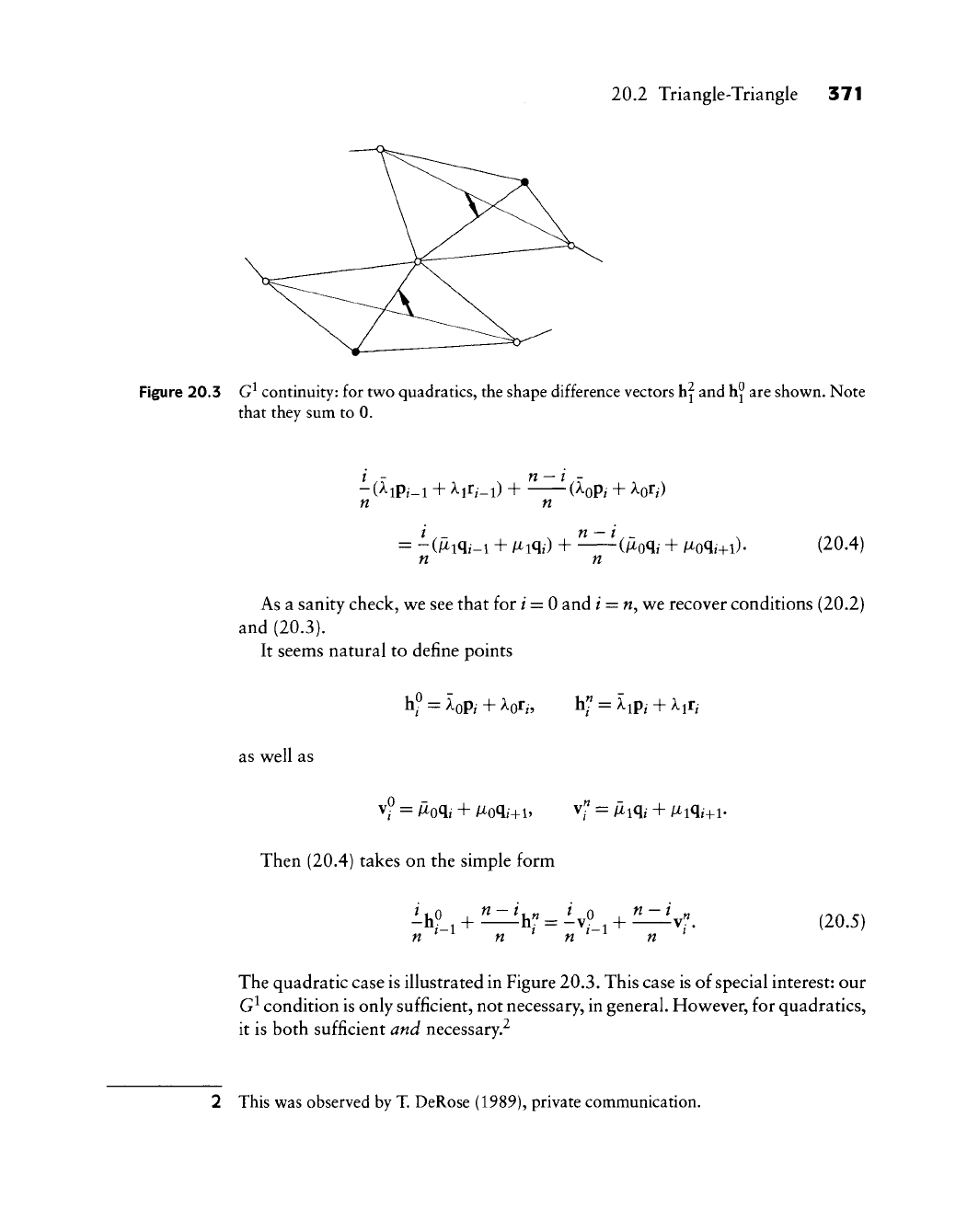
20.2 Triangle-Triangle 371
Figure 20.3 G^ continuity: for two quadratics, the shape difference vectors h^ and hj are shown. Note
that they sum to 0.
-(Aip,_l + Air,_i) + (Aop/ +
koTi)
n n
/ _ n
—
i _
= -(/xiq,_i + Miq,) +
(/xoq,-
+ /xoq/+i).
n n
(20.4)
As a sanity check, we see that for / = 0 and / =
w,
we recover conditions (20.2)
and (20.3).
It seems natural to define points
hf =
AoP,-
+ Aor„ hf = Aip,- + k^ti
as well as
Then (20.4) takes on the simple form
« n n n
(20.5)
The quadratic case is illustrated in Figure
20.3.
This case is of special interest: our
G^ condition is only sufficient, not necessary, in general. However, for quadratics,
it is both sufficient and necessary.^
2 This was observed by
T.
DeRose (1989), private communication.
